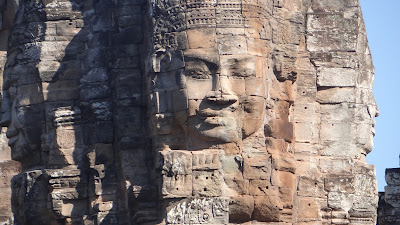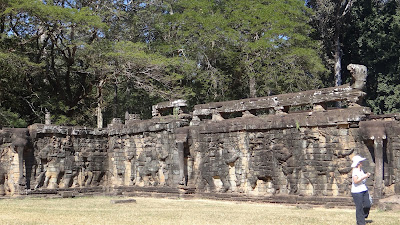The Ruins of Angkor - 3 - Angkor Thom
Angkor Wat, that we have described in the previous post, was primarily a temple complex measuring 1.2 km x 1.2 km. Angkor Thom on the other hand, was a city, the capital city of the Angkor empire with a walled area of approximately 3 km x 3 km. This city was built in the 12th century by Suryavarman VII and his successors who lived there till the eventual collapse of the Angkor empire. As a city it had multiple palaces, numerous temples and many other structures.
Like all Angkor structures, Angkor Thom is surrounded by a moat, walls and four gates (plus one funeral gate for dead bodies)
This is where we enter the city through the South Gate. [ Please click on the images to enlarge them]
Like all Angkor structures, Angkor Thom is surrounded by a moat, walls and four gates (plus one funeral gate for dead bodies)
This is where we enter the city through the South Gate. [ Please click on the images to enlarge them]
These large faces are characteristic of Angkor Thom
The moat is crossed over a causeway that has a row of Gods on one side and a row of Demons, Asuras, on the other
At the centre of the city is the temple of Bayon, that is a similar to Angkor Wat but smaller. Also the most interesting feature of the Bayon Temple is the large Chaturanan, Four Faced, Brahma statues.
Inside the temple there are many beautifully sculptured panels depicting the lives of the Khmer people and a few well preserved statues of the Buddha
But the really interesting part of the Bayon temple are the large faces of Brahma that are everywhere
There are hundreds of temples and structures within the city limits of Angkor Thom and one such structure is the Elephant Terrace, a kind of amphitheatre, used by the king to review his soldiers, celebrate festivals and for any large public gathering.
Most of the carvings are that of elephants except the one below, where we see Garuda
ropes stretched between towers like this were used by tightrope walkers, and below we see the three headed elephant, Airawat, used by Indra
and finally we have the Royal Crematorium, used by the King and his family. All other corpses were cremated outside the city limits


































Comments